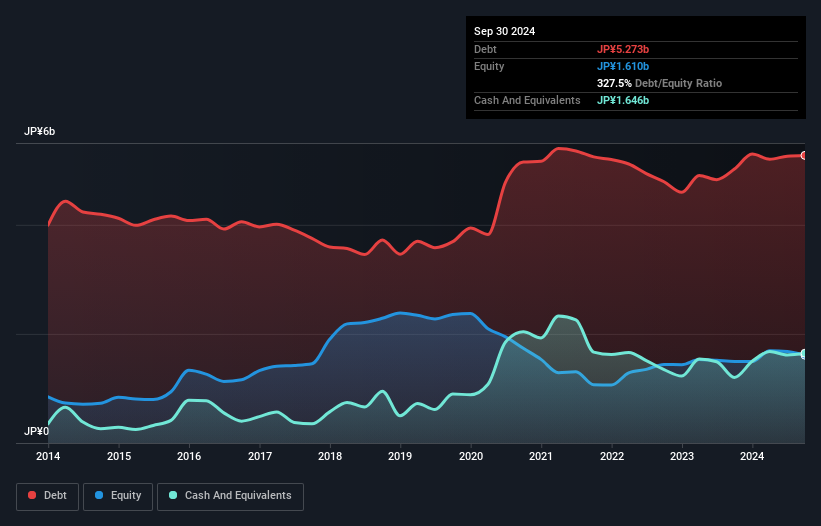- Japan
- /
- Electronic Equipment and Components
- /
- TSE:7746
Does Okamoto Glass (TSE:7746) Have A Healthy Balance Sheet?
Some say volatility, rather than debt, is the best way to think about risk as an investor, but Warren Buffett famously said that 'Volatility is far from synonymous with risk.' So it might be obvious that you need to consider debt, when you think about how risky any given stock is, because too much debt can sink a company. We note that Okamoto Glass Co., Ltd. (TSE:7746) does have debt on its balance sheet. But should shareholders be worried about its use of debt?
Why Does Debt Bring Risk?
Debt and other liabilities become risky for a business when it cannot easily fulfill those obligations, either with free cash flow or by raising capital at an attractive price. If things get really bad, the lenders can take control of the business. However, a more usual (but still expensive) situation is where a company must dilute shareholders at a cheap share price simply to get debt under control. Of course, plenty of companies use debt to fund growth, without any negative consequences. The first step when considering a company's debt levels is to consider its cash and debt together.
View our latest analysis for Okamoto Glass
What Is Okamoto Glass's Net Debt?
You can click the graphic below for the historical numbers, but it shows that as of September 2024 Okamoto Glass had JP¥5.27b of debt, an increase on JP¥5.02b, over one year. However, it does have JP¥1.65b in cash offsetting this, leading to net debt of about JP¥3.63b.

How Healthy Is Okamoto Glass' Balance Sheet?
The latest balance sheet data shows that Okamoto Glass had liabilities of JP¥2.75b due within a year, and liabilities of JP¥3.56b falling due after that. Offsetting these obligations, it had cash of JP¥1.65b as well as receivables valued at JP¥942.0m due within 12 months. So it has liabilities totalling JP¥3.72b more than its cash and near-term receivables, combined.
This deficit is considerable relative to its market capitalization of JP¥3.89b, so it does suggest shareholders should keep an eye on Okamoto Glass' use of debt. This suggests shareholders would be heavily diluted if the company needed to shore up its balance sheet in a hurry.
In order to size up a company's debt relative to its earnings, we calculate its net debt divided by its earnings before interest, tax, depreciation, and amortization (EBITDA) and its earnings before interest and tax (EBIT) divided by its interest expense (its interest cover). The advantage of this approach is that we take into account both the absolute quantum of debt (with net debt to EBITDA) and the actual interest expenses associated with that debt (with its interest cover ratio).
Okamoto Glass shareholders face the double whammy of a high net debt to EBITDA ratio (7.5), and fairly weak interest coverage, since EBIT is just 2.2 times the interest expense. The debt burden here is substantial. However, the silver lining was that Okamoto Glass achieved a positive EBIT of JP¥116m in the last twelve months, an improvement on the prior year's loss. The balance sheet is clearly the area to focus on when you are analysing debt. But you can't view debt in total isolation; since Okamoto Glass will need earnings to service that debt. So when considering debt, it's definitely worth looking at the earnings trend. Click here for an interactive snapshot.
Finally, while the tax-man may adore accounting profits, lenders only accept cold hard cash. So it's worth checking how much of the earnings before interest and tax (EBIT) is backed by free cash flow. Over the last year, Okamoto Glass actually produced more free cash flow than EBIT. There's nothing better than incoming cash when it comes to staying in your lenders' good graces.
Our View
Okamoto Glass's net debt to EBITDA and interest cover definitely weigh on it, in our esteem. But the good news is it seems to be able to convert EBIT to free cash flow with ease. When we consider all the factors discussed, it seems to us that Okamoto Glass is taking some risks with its use of debt. While that debt can boost returns, we think the company has enough leverage now. When analysing debt levels, the balance sheet is the obvious place to start. But ultimately, every company can contain risks that exist outside of the balance sheet. For example Okamoto Glass has 3 warning signs (and 2 which are significant) we think you should know about.
At the end of the day, it's often better to focus on companies that are free from net debt. You can access our special list of such companies (all with a track record of profit growth). It's free.
New: AI Stock Screener & Alerts
Our new AI Stock Screener scans the market every day to uncover opportunities.
• Dividend Powerhouses (3%+ Yield)
• Undervalued Small Caps with Insider Buying
• High growth Tech and AI Companies
Or build your own from over 50 metrics.
Have feedback on this article? Concerned about the content? Get in touch with us directly. Alternatively, email editorial-team (at) simplywallst.com.
This article by Simply Wall St is general in nature. We provide commentary based on historical data and analyst forecasts only using an unbiased methodology and our articles are not intended to be financial advice. It does not constitute a recommendation to buy or sell any stock, and does not take account of your objectives, or your financial situation. We aim to bring you long-term focused analysis driven by fundamental data. Note that our analysis may not factor in the latest price-sensitive company announcements or qualitative material. Simply Wall St has no position in any stocks mentioned.
About TSE:7746
Okamoto Glass
Manufactures and sells special-purpose glass for industrial use and multi-layer film evaporation products.
Imperfect balance sheet with very low risk.
Market Insights
Community Narratives



